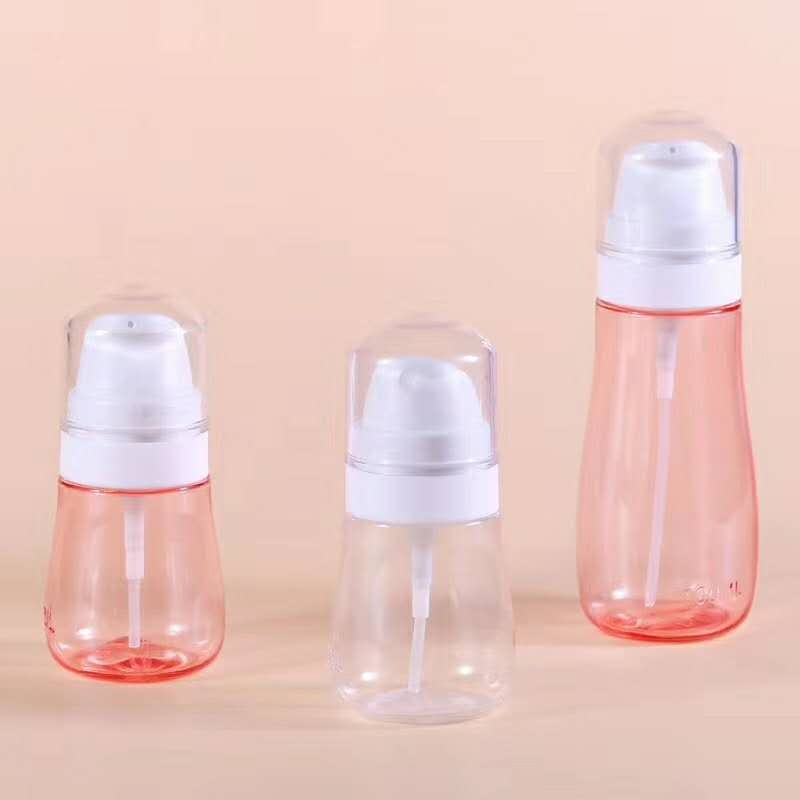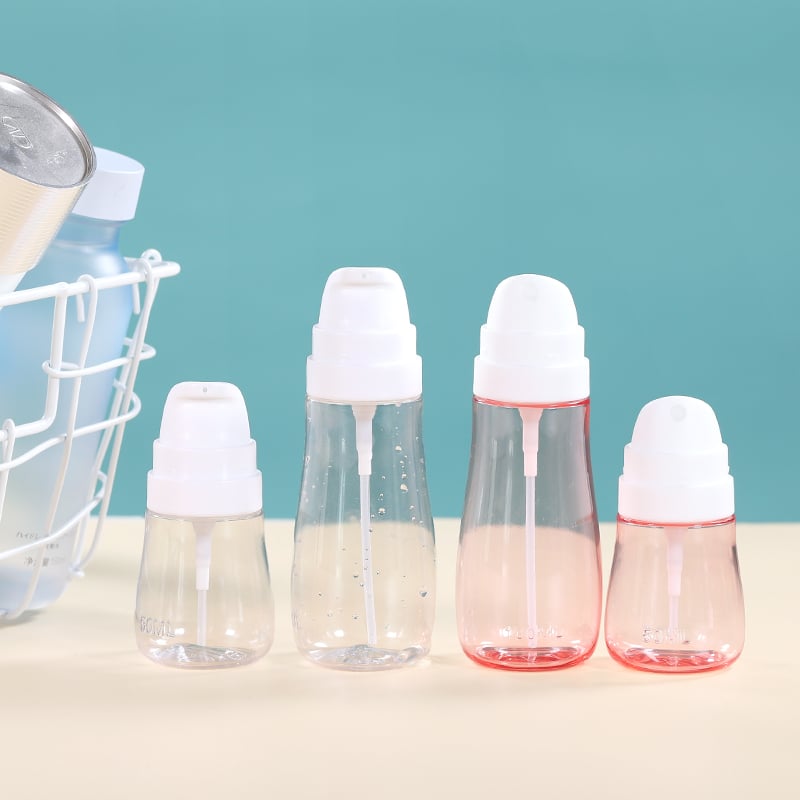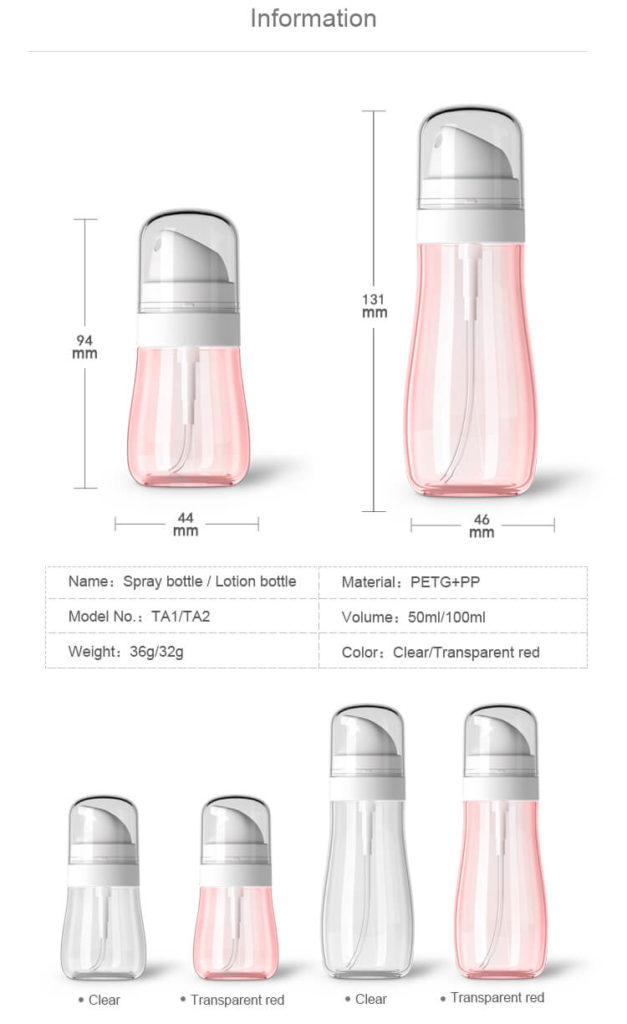Plastic bottles
Plastic bottles are mainly made of polyethylene or polypropylene and other materials and added a variety of organic solvents after. Plastic bottles are made from PET, PE, and PP materials, and are heated at high temperatures with appropriate organic solvents. The plastic containers are blown, blown or injection molded by plastic molds. Mainly used for beverages, food, pickles, honey, dried fruit, edible oil, agricultural and veterinary medicine, and other liquid or solid disposable plastic packaging containers. The plastic bottle is not easy to break, low cost, high transparency, food-grade raw materials, and so on.
Materials
The plastic bottles are plastic container that uses PET, PE, and PP as raw materials, after adding the corresponding organic solvent and heating at high temperature, it is blown, blown, or injection molded through the plastic mold. Plastic bottles are not easy to break, are low cost, have high transparency, have food-grade raw materials, and so on.
Material side effects have been reported that long-term consumption of food contaminated by polyethylene molecules, will make people dizzy, have headaches, nausea, loss of appetite, memory, and even anemia. Therefore, the use of plastic bottles of vinegar is harmful to human health and not a benefit. Therefore, the Family should use glass containers to replace the plastic packaging for spices and so on. Special attention should be paid when using plastic products, do not contact vinegar, or cleaning agents, and avoid direct sunlight, and high temperatures, so as to avoid chemical reactions. In addition, when you buy plastic tableware, you should select the goods with PE (polyethylene) or PP (polypropylene) marked, decorative patterns, and colorless tasteless, smooth surfaces of plastic products.
Method of preparation
There are many ways to make polyethylene, the most common of which is to polymerize ethylene at 200 ~ 300 °C and 1000 ~ 2000 atmospheric pressure. In polyethylene, no other substances are added. The resulting polyethylene is low in density and soft in texture and has high stability to sunlight, air, water, and chemical reagents, so no additional stabilizer or plasticizer is needed, stabilizers and plasticizers are mostly toxic or highly toxic.
Characteristics
Plastic bottles are easy to carry, not afraid of falling, have acid and alkali resistance characteristics, easy production, and are also conducive to recycling.
Health Advice
The main raw material for making beverage bottles is polypropylene plastic, which is non-toxic and harmless and is used for holding soft drinks of Cola type, if the long-term storage of wine, vinegar, and other fat-soluble organic matter, it will occur chemical reactions. Long-term consumption of ethylene-contaminated food will make people dizzy, headache, nausea, loss of appetite, memory, and other serious cases may lead to anemia. In addition, the use of beverage bottles filled with wine, vinegar, etc. , the bottle will be oxygen, ultraviolet radiation and other effects of aging, releasing more ethylene monomer, so that long-term storage in the bottle of wine, vinegar, and another metamorphism. Beverage companies are advised to note the following warnings on the packaging of their beverage bottles:
Bottle bottom marking
Bottom Marker
“
Number One”Pete
Mineral water bottle, carbonated drink bottle
Don’t recycle the beverage bottles to fill with hot water
Use: HEAT-RESISTANT TO 70 °C, only suitable for filling warm or cold drinks, filled with high-temperature liquid, or heating is easy to deformation, harmful substances melting out. Moreover, the scientists found that plastic No. 1 may release the carcinogen DEHP after 10 months of use, which is toxic to the testes.
“number two” HDPE
Cleaning products, bath products
Do not recycle if it is not thoroughly cleaned
Use: can be carefully cleaned after reuse, but these containers are usually not easy to clean, residual cleaning supplies, become a hotbed of bacteria, you had better not recycle.
Number three PVC
It is rarely used for food packaging and is best not bought
Number Four.”LDPE
The fresh-keeping film, plastic film, etc.
Keep the plastic wrap out of the food and put it in the microwave
Use: heat resistance is not strong, usually, qualified PE film in a temperature of more than 110 °C will appear hot melt phenomenon, which will leave some plastic bodies can not decompose. And, wrap the food with plastic wrap to heat, the fat in the food will be easy to keep the plastic wrap of harmful substances dissolved. Therefore, the food into the microwave oven, the first to remove the wrapped plastic.
“number five, ” PP
Microwave lunch box
When you put it in the microwave, take the lid off
Use: the only plastic box that can fit in a microwave oven can be reused after careful cleaning. Special attention needs to be paid to some microwave dinner boxes, the box body is indeed made of 5 PP, but box cover is made of 1 PE, because PE can not withstand high temperatures, it can not be put into the microwave with the box body. To be on the safe side, take the lid off the container before you put it in the microwave.
“Six” PS
Bowl-packed instant noodle box, fast food box
Don’t put instant noodles in the microwave
Use: Heat and cold resistance, but can not put into the microwave oven, so as not to release chemicals due to high temperature. And can not be used for loading strong acids (such as orange juice), or strong alkaline material, because it will be broken down to the human body bad polystyrene, easy to cause cancer. Therefore, you should try to avoid using fast food boxes and packing hot food.
Number seven, PC
Other categories: Kettle, Cup, milk bottle
HEAT-RELEASED BISPHENOL A in PC adhesive
Use: a widely used material, especially in baby bottles, that is controversial because of its BPA content. Lin Hanhua, associate professor of the Department of Biology and Chemistry at the City University of Hong Kong, said that in theory, as long as 100 percent of BPA is converted into a plastic structure in the process of making a PC, it means that there is no BPA in the product, let alone any release. However, if a small amount of BPA is not converted into the plastic structure of the PC, it may be released into food or drink. Therefore, care must be taken when using this plastic container.
The higher the temperature was, the more BPA was released and the faster the release rate was. Therefore, do not use PC water bottles to hold hot water in order to avoid increasing the rate and concentration of BPA (if any) released. If your kettle is numbered 7, the following methods can reduce the risk:
Do not use a dishwasher or a dishwasher to clean the kettle.
Do not heat when in use.
Keep the kettle out of direct sunlight.
Wash with baking soda powder and warm water before first use, and dry naturally at room temperature. Because BISPHENOL A is released more in the first and long-term use.
:: If the container is broken or damaged in any way, it is recommended not to use it as the plastic is prone to hiding bacteria if it has small pits on the surface.
:: Avoid the repeated use of aged plastic appliances.
Waste beverage
As you know, a large number of plastic products used in food packaging are of three kinds: polyvinyl chloride, polyethylene, and polystyrene. For a short period of time used to hold cooking oil, human health is not harmed. However, using them to hold cooking oil for a long time will contaminate food and cause harm to the human body.
This is because this type of packaging bottles with high transparency, easy to age, and other characteristics, in the air, will be affected by oxygen, ozone, and ultraviolet radiation and produce a strong odor, coupled with polymer itself aging, if used for long-term storage of cooking oil, tends to spoil these foods.
In addition, the element vinyl chloride in polyvinyl chloride is not only toxic, but also highly toxic hydrogen chloride and chlorine, which are easily broken down in acids and oils, and plasticizers added to polyvinyl chlorides, such as phthalates, are toxic, lead, cadmium, and Organotin, which are used as stabilizers, are toxic chemicals that are highly toxic and readily soluble in oils and fats. Although plastic polystyrene is a lowly toxic material, its components styrene and volatile components Ethylbenzene, and cumene are toxic, and very easily dissolved in oils and fats. Plastic polyethylene itself is not toxic. However, when it comes into contact with oils and fats, it breaks down into low-molecular-weight compounds, which are toxic when dissolved in oils and fats.
Bottle development
Coating technology for barrier plastic bottles has been on the decline, with Krones AG of Germany and Tetra Pak of Illinois cutting back production. Krones developed BestPET technology with coca-cola to coat bottles with silica-based coatings. A spokesman for the company said the technology was outdated due to its high cost and inadequate barrier performance to oxygen, Tetra Pak has also halted work on a silicon dioxide plasma coating system for the inner walls of PET bottles.
In addition, Italian company SIPA has developed a new barrier coating for PEN bottles, its product is Smart Coat, its process flow is: blow molding process after the bottle, after the dip-coating process, the bottles are then immediately placed in an infrared oven to allow them to dry quickly. After a second coating, the bottles are then cured under ultraviolet radiation. A standard dip-coating unit can handle about 12,000 plastic bottles per hour. One of the goals of the PET bottle is to fill carbonated drinks. According to the company, a 0.5-liter, single-use, coated PET bottle can last up to a year on the shelf, the shelf life of uncoated PET bottles is only seven weeks.
British innovative plastics technology (AFT) has developed a patented water-based flow coating process to coat the outer surface of a special barrier thermoplastic resin preform. The resin solidifies after the preform is coated, the preform can be redrawn and blow-molded on standard processing equipment. Apt claims that this coating process improves CO barrier performance by 3-4 times compared to uncoated PET bottles, and that Husky is negotiating the transfer of technology with APT, to get a license to manufacture the coating equipment, which is designed to process 30,000 preforms per hour, says Robert, director of APT. Lee said. The technology has been purchased by a leading beverage producer and used to process non-alcoholic beverage bottles.
The Plastic Processing Institute (IKV) of the University of Aachen, Germany, has transferred its plasma coating technology on the inner wall of plastic bottles to a sidebar, and IKV has also developed a coating technology on the outer wall of plastic bottles, which uses a barrier coating of 20-150nm, similar to the inner wall coating process, the CO barrier performance of PET bottles can be improved by a factor of 4. The processing cycle of the technical production system is 15 seconds, the researchers set development goals for cutting the processing cycle to less than 10 seconds, using more powerful vacuum pumps, and other improved detection devices.
Forming principle
The plastic bottles are filled by the gun mold under a certain temperature and pressure blow molding can be formed by preform processing, or directly by injection blow molding a machine processing.
Questions
1 in the design of extruded plastic bottles, if the material is high-density polyethylene or polypropylene, the cross-section of plastic bottles should be rectangular or oval, for the material is Low-density polyethylene or other flexible plastic bottles, its cross-section should be circular. This allows the contents to be extruded from the plastic bottles. The plastic parts used with the plastic bottle mouth are mainly the bottle cap and the sealer. The design of the plastic bottle mouth should focus on how to make the plastic bottle mouth fit the bottom of the plastic bottles with the CAP and the Sealer, which is the weak part of the plastic bottles’ mechanical properties. Therefore, the bottom of the plastic bottle is generally designed to concave; plastic bottles’ corners, and concave, are done a large arc over. In order to facilitate the stacking of plastic bottles, and increase the stacking stability of plastic bottles, plastic bottles should be designed at the bottom of the groove.
When the surface of the plastic bottles is labeled, the labeled surface should be even. A “frame frame” can be designed on the surface of the plastic bottle, so that the label can be accurately positioned without moving. In blow molding, and parison bloating the first contact with the site always tends to advance the hardening of the site. Therefore, the wall thickness of this part is also larger. The edge and corner are the final contact of parison bloating, where the wall thickness is smaller. Therefore, the plastic bottles’ edge and eraser parts should be designed into a rounded corner. Changing the surface shape of the plastic bottles, such as the middle part of the plastic bottle is relatively thin, increasing the circumferential groove or convex rib on the surface of the plastic bottles, which can improve the rigidity and bending resistance of the plastic bottles. A longitudinal groove or stiffener can eliminate the plastic bottles under the long-term load of the offset, droop or deformation.
The printed surface of the plastic bottle is the most concentrated part of the consumer’s attention. The printing surface should be smooth and continuous. If the plastic bottles contain a handle, groove, and stiffener, the design should be careful not to cause inconvenience to the printing operation. In elliptical plastic bottles, rigidity is also higher, but the cost of mold manufacturing is higher. Therefore, in order to ensure the stiffness of plastic bottles, in addition to the selection of high-stiffness materials, but also through the plastic bottles shape design, enhance the stiffness and load-resistant strength of plastic bottles.
4 because most plastics have the sensitivity of a notch, the plastic bottle is easy to produce cracks and cracks at the sharp corner, the root of the thread of the notch, the neck, and so on, so these parts should be designed as rounded corners. It is necessary to support most of the load of the plastic bottles at the turning point of the rectangular plastic bottle. Therefore, increasing the wall thickness of the plastic bottle locally is beneficial to improve the rigidity and load resistance strength of the plastic bottles.
Across the Pacific
British explorer Rothschild Family Davy has a new challenge: sailing more than 17,000 km across the Pacific Ocean in a boat made from 12,000 discarded plastic bottles. More than a month later, the plastic ship finally docked for the first time for supplies. After leaving San Francisco harbor on March 24, the ship has now arrived in the Pacific island nation of Christmas Island, the first time the six-member crew has landed. Although made from discarded plastic bottles, the 18-meter-long plus tiki has proven its ability to withstand rough seas. The ship is also equipped with a number of laptops, Global Positioning System, and satellite phones, which are powered by solar panels, and two sports bikes.
Garment Fabric
We all know that used plastic bottles can be recycled, but what are they used for? This we are not very clear, plastic bottles have a lot of value after recycling, among them, plastic bottles can also be spun into yarn, and turned into clothing fabrics, is not it amazing?
Plastic is one of the great inventions of mankind, but also difficulty to degrade and becomes a headache source of garbage, and harm to the environment. In fact, waste plastic is not garbage, through environmental technology can be turned into treasure. The main materials of plastic bottles are generally PP polypropylene and PET polyethylene terephthalate, which is one of the important raw materials for making clothing fabrics.
According to the Beijing Institute of Textile Science, the clothes are very cool to wear, as the fabric has the function of “moisture absorption and quick-drying”, making it eco-friendly and comfortable for consumers to wear. “Our business philosophy is to be green, not only using renewable resources as raw materials, but also striving to create emission-free standards in the production process, ” Mao said, “The traditional way to produce polyester internationally is through chemical refining, and we have been able to bring the quality of our products up to the standards of the original products through technological innovation. ”
Development
At present, the world economy is changing, and the domestic industrial structure is also in the stage of continuous upgrading. In the current industrial upgrading process, a number of low-value-added enterprises by a variety of operating difficulties encountered unprecedented challenges, faced a variety of difficulties. Today, we’re talking about the plastic bottle industry in the midst of a transformation storm.
There are all kinds of problems with plastic bottles. Let’s take a closer look. First of all, plastic bottles belong to labor-intensive industries, the current rising labor costs, for plastic bottle enterprises, the cost of Labor has become a huge pressure. Secondly, the rising prices of raw materials, by the market all kinds of costs rise, raw materials rise significantly, which creates another layer of pressure for plastic bottle enterprises. Third, with the European debt crisis and the weakening of the world economy, foreign trade orders for plastic bottles have gradually declined, and many foreign trade enterprises have turned to the domestic market, which has brought more pressure to the already competitive domestic plastic bottle market, the price war is more and more fierce, the enterprise’s profit is more and more low.
Plastic bottle manufacturers, in the current situation of various pressures, should take the road of industrial upgrading, in the plastic packaging field to take the road of innovation, and strive to improve the added value of plastic bottles. From the plastic bottle production, design, and sales of each link continuous improvement.



